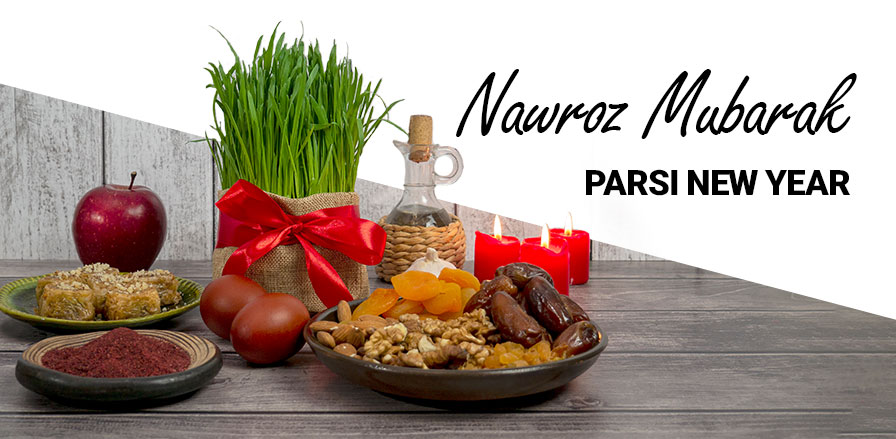Parsi New Year: History & Significance
Indastro wishes all an auspicious Jamshed-e-Navroz! Read our article to learn about this festival’s significance, history and rituals to celebrate it.
It is an auspicious day today as the Parsi community celebrates New Year, also known as ‘Jamshed-e-Navroz’ after the legendry king of Persia, Jamshed who had introduced the Parsi calendar. ‘Navroz’ means the ‘new day’. The festival date commences at the strike of vernal equinox when the sun passes through the equator. The date is calculated according to the ‘Shahanshahi’ calendar and in India this festival is mostly celebrated in Gujarat and Maharashtra.
History of Parsi New Year
The legend goes that the Persian king, Jamshed, saved his people from an apocalypse that came destined to kill everyone with extreme cold. But in the kingdom of Jamshed, there was no excessive heat or cold, no pre-mature deaths due to any natural calamity and there was everlasting peace and prosperity.
The festival of ‘Navroz’ came to India with the Parsis more than 1000 years ago, when the Arab conquest of Iran made them migrate. Also, this festival is said to have been formally introduced in India by Ghiyas ud-din Balban.
Significance of the festival
The tradition of Navroz is traced to ancient history, dating back to more than 3000 years ago. The festival gets its name from King Jamshed who was known for his right conduct and truthfulness. It is precisely this that the Parsi community in India believes in following - the virtuous path of kindness and truth, which Navroz commemorates.
What are the rituals followed on this day?
Navroz, the Iranian New Year, marks the beginning of the spring season and is celebrated with great enthusiasm and energy in various Parsi communities across the globe, including India.
- On this day, Parsis engage in good deeds for others by being kind, maintaining decorum in speech, good conduct and norms of behaviour.
- The house is cleaned as a symbol of cleansing their souls.
- New clothes are worn that depict the leaving of bad behaviour and bad memories behind in order to move forward into the new year with renewed energy of hope and truth.
- They cook an elaborate meal for family and friends as a gesture of good wishes, peace and prosperity for their loved ones.
- They visit the fire temple and offer milk, flowers, fruits, and sandalwood to the fire to remove negativity from their lives.
- They pray at the Atash Behram (Fire of Victory) that is placed in the Zoroastrian temple as an eternal flame. The Parsi High Priest relates the important message of instilling oneself with good thoughts, doing good deeds, speaking with courtesy, and kindness for everyone irrespective of status.
- Homes are decorated with flowers, lights and other decorative items. Beautiful symbolic patterns are drawn outside the homes to attract good luck, peace and prosperity.
- They draw symbols of fish outside their homes or keep fish in bowls in their homes to attract growth and prosperity.
- They keep a silver coin, a painted egg and an earthenware plate with sprouted beans or wheat inside their house for abundance in productivity.
On this day, the Parsi community in India partakes in community festivities that include a bonfire, a common feast for the community, musical performances and traditional sports. They dress up in their traditional attire for this special day and decorate their homes with Rangoli designs, burn incense sticks to enhance the surroundings and also fill the heart with love and gratitude for the Almighty, with the prayer to provide them with the best of peace and prosperity.
They invite guests and sprinkle rose water on them, entertain them with love and affection by offering them delicacies and a fine dining experience, which not only deepen the relations but also boost mutual understanding. After praying and enjoying a good feast and get together with friends and families, they greet each other with blessings and warm wishes for the auspicious day and the new year.
Indastro top 10 Products
Translate











 Which Zodiac Sign Should You Avoid Dating?
Which Zodiac Sign Should You Avoid Dating?
 Astrological predictions unveiling attributes and future prospects of your daughter!
Astrological predictions unveiling attributes and future prospects of your daughter!
 Personality of Your Baby as per their Zodiac Sign
Personality of Your Baby as per their Zodiac Sign
 The Dark Side of Sagittarius
The Dark Side of Sagittarius
 When Gemini Turns Dark!!
When Gemini Turns Dark!!
